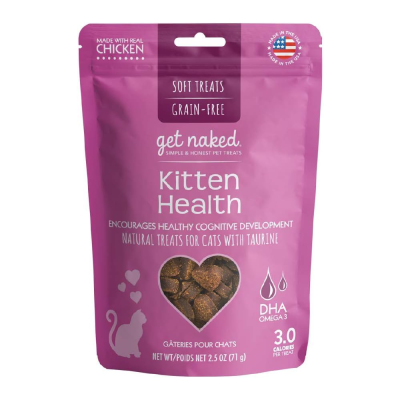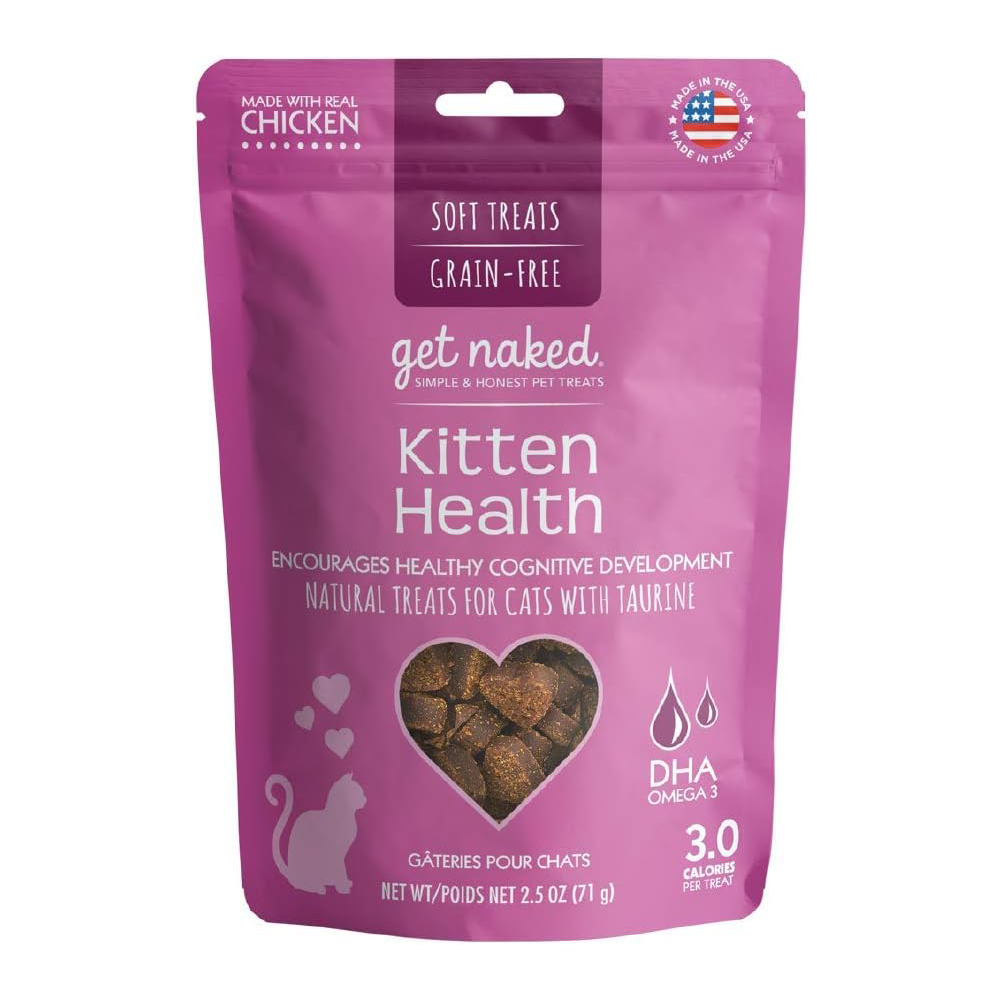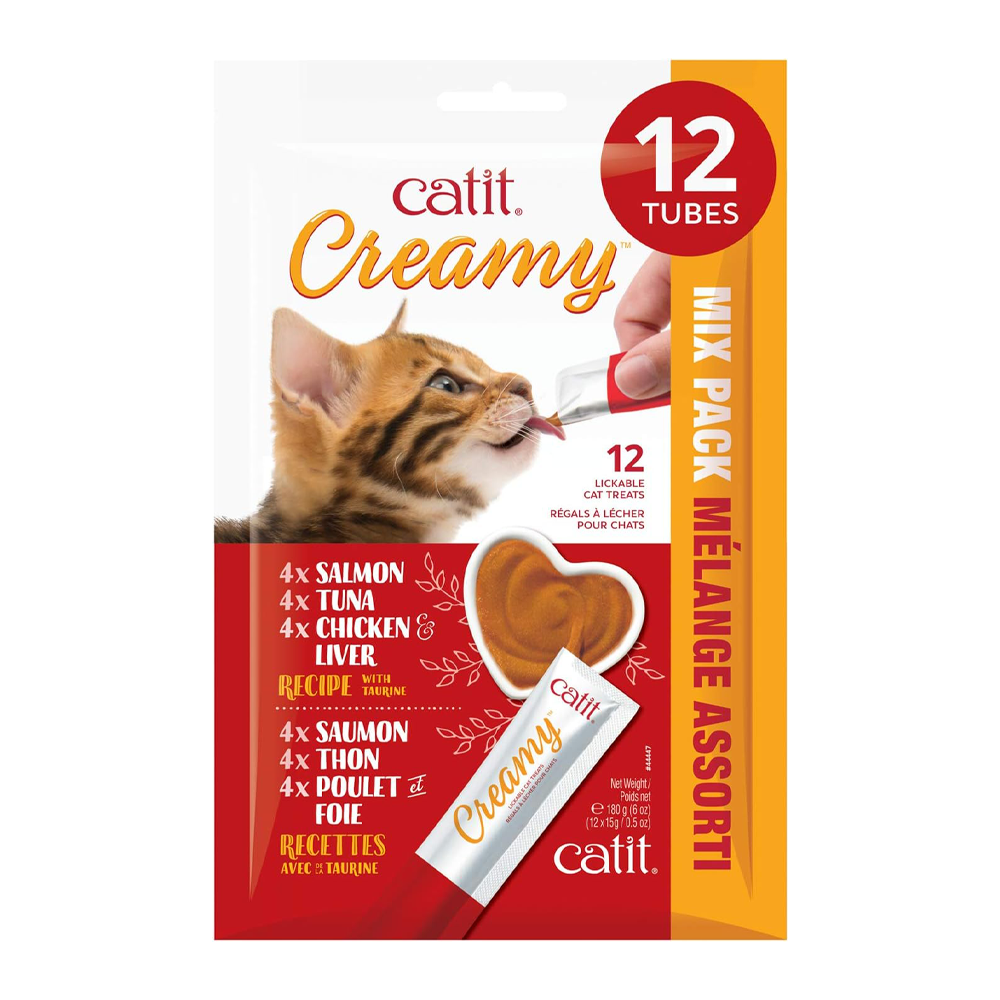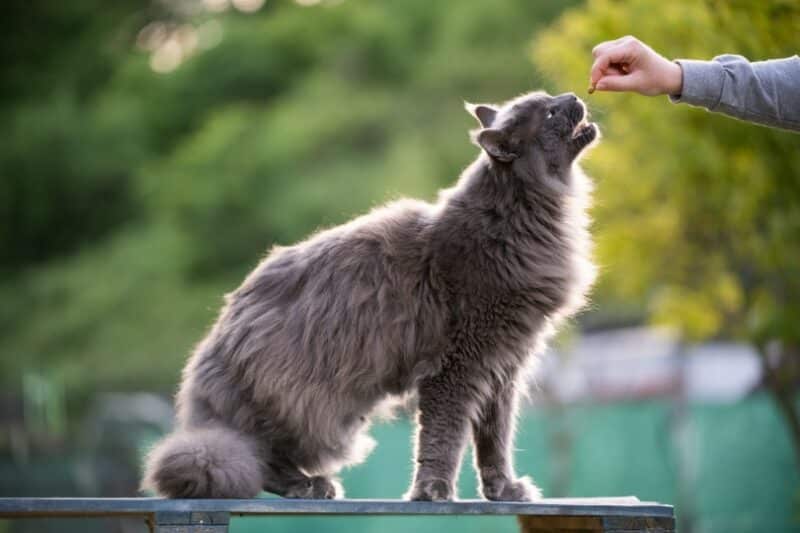
Cats are highly food-motivated animals that will do just about anything for their favorite treat. However, they are also picky and won’t work for just anything. Whether you are clicker training your cat to perform tricks or just want to offer a tasty reward for good behavior, you need a treat that your cat loves.
The best cat treats are nutritious and filled with healthy ingredients but are also scrumptious enough to be motivating. We went through tons of cat treat reviews and compiled a list of the 10 best cat treats in Canada this year. Here’s everything that you need to know about shopping for cat treats!

A Quick Look at Our Favorites in 2024
| Image | Product | Details | ||
|---|---|---|---|---|
| Best Overall |

|
Orijen Tundra Freeze-Dried Cat Treats |
|
CHECK PRICE |
| Best Value |

|
Friskies Party Mix Cat Treats |
|
CHECK PRICE |
| Premium Choice |

|
Cat-Man-Doo Dried Bonito Flakes for Cats |
|
CHECK PRICE |
| Best for Kittens |

|
N-Bone Get Naked Kitten Health Soft Treats |
|
CHECK PRICE |

|
Catit Creamy Lickable Cat Treat |
|
CHECK PRICE |
The 10 Best Cat Treats in Canada
1. Orijen Tundra Freeze-Dried Cat Treats — Best Overall

| Flavor: | Goat, venison, wild boar, duck, and mackerel |
| Item Form: | Freeze-dried raw |
Orijen Tundra Freeze-Dried Cat Treats are the overall best cat treats in Canada because they combine irresistible flavor with top-notch nutrition. You can feel good about rewarding your cat with these all-natural, all-meat, bite-sized treats. They are safe for cats with stomach sensitivities, too, as they have novel proteins that aren’t frequently found in cat food or treats.
These treats from Orijen offer something different than other traditional cat treats. They are safe for most cats with allergies, they are a limited-ingredient recipe, and they are 100% preservative-free. The only downside is the price. They’re more expensive than many other brands. However, we think that it’s worth it for this product’s quality.
- Novel protein
- No preservatives
- Limited-ingredient recipe
- Grain-free
- Safe for cats with allergies or food sensitivities
- Expensive
2. Friskies Party Mix Cat Treats — Best Value

| Flavor: | Chicken and gravy |
| Item Form: | Dry |
The best cat treats in Canada for the money is Friskies Party Mix Cat Treats. These are relatively inexpensive compared to many other options without sacrificing nutrition or flavor. At under 2 calories per treat, you can spoil your kitty without loading them up on empty calories. The crunchy texture helps clean teeth while your cat chews and the variety of shapes keep them engaged. These treats are available in large buckets that you can buy in bulk, making them great for multi-cat households.
The size of the packaging could be a problem if you only have one cat and don’t feed them many treats. While they keep for a long time, these treats will eventually go stale, which, in some cases, can lead to waste.
- Inexpensive
- Under 2 calories per treat
- Helps keep teeth clean
- Large sizes for multi-cat households
- Large packaging may lead to excessive waste
3. Cat-Man-Doo Dried Bonito Flakes for Cats — Premium Choice

| Flavor: | Fish |
| Item Form: | Flakes |
Bonito, or skipjack, is a medium-sized ocean fish related to tuna. These Cat-Man-Doo Dried Bonito Flakes are dehydrated pieces of this fish. These fish flakes can be given as treats or used as food toppers for cats that need extra incentive to eat.
Nutrition-wise, Bonita flakes are packed full of protein and omega-3 fatty acids. These Cat-Man-Doo treats also have added glucosamine and chondroitin to promote joint health.
The biggest issue with Cat-Man-Doo Bonita Flakes is that they are paper-thin and difficult to feed individually. They crumble up at the bottom of the bag, leaving only dust. While this makes them great for sprinkling on top of cat food, it can be difficult to feed them as treats without making a mess.
- High in protein
- Added nutrients to promote your cat’s health
- No preservatives
- Can be fed as treats or food toppers
- Expensive
- Crumble easily
4. N-Bone Get Naked Kitten Health Soft Treats — Best for Kittens

| Flavor: | Chicken |
| Item Form: | Granule |
N-Bone Get Naked Kitten Health Soft Treats are designed for kittens. Made with 100% real chicken, they are under 3 calories per treat. They are fortified with vitamins and nutrients to keep your kitten growing, active, and healthy. They are wheat-, corn-, and soy-free to avoid upsetting sensitive tummies but are tasty enough to use daily for training purposes.
These treats from N-Bone might be too big for some kittens. However, their soft texture makes them easy to break up into smaller pieces, and most cats will happily lap up the crumbs.
- Fortified with vitamins for healthy growth and development
- All-meat recipe
- Safe for sensitive stomachs
- Under 3 calories per treat
- Soft and easy to chew
- Too large for tiny kittens
5. Catit Creamy Lickable Cat Treat

| Flavor: | Chicken and liver, tuna, salmon, seafood |
| Item Form: | Stick |
Catit Creamy Lickable Cat Treats are different than traditional cat treats. These delicious sticks are lickable, squeezable treats meant for hand-feeding your cat. They are basically wet food in a squeeze tube. They can be used as food toppings for cats that need the incentive to eat their meals. Catit treats are ideal for impromptu trips. They can also be squeezed into ice cube trays and frozen to provide your cat with a cool treat on a hot day.
While these treats are ideal for hand feeding, many cats won’t lick them out of the package. They do love them when squeezed out into a food bowl or frozen into cubes. In this case, it may be more economical to use canned wet food than these more expensive cat treats.
- Easy to travel with
- Easy to freeze
- Doubles as treats and meal toppers
- Not all cats will lick it out of the tube
- Expensive
6. Feline Greenies Cat Treats

| Flavor: | Chicken |
| Item Form: | Dry |
Feline Greenies Cat Treats Adult Natural Dental Care is approved by the Veterinary Oral Health Council (VOHC) as an effective method of controlling tartar on your cat’s teeth. They contain no artificial ingredients and have added vitamins and minerals to promote oral health. These treats are well-liked by most cats and are low in calories, making them safe to feed daily.
Greenies cat treats contain less meat than most alternatives, which isn’t ideal. It also makes them less appealing to picky cats, which is unfortunate because these treats do a great job of cleaning teeth.
- Natural ingredients
- Low calorie
- Designed to promote healthy teeth
- VOHC approved
- Contains wheat
- Less meat than many other brands
7. Delectables Squeeze Up Interactive Wet Cat Treats

| Flavor: | Tuna |
| Item Form: | Wet |
Delectables Squeeze Up Interactive Wet Cat Treats offer thick, puréed wet food in squeezable tubes. They can be hand-fed or squeezed into a bowl up to three times a day to supplement your cat’s diet. These treats are loved by cats and are nutritious enough to feed daily.
The packages are slightly smaller than many other brands of squeezable treats. This could be good or bad, depending on the size of the cat that you’re feeding. As with any treat, cats can be picky about these, and not all will love the flavor.
- Can be fed as part of your cat’s regular diet
- Wet food so high in moisture content
- Smaller packages than many other brands
- Not liked by all cats
8. Purebites Chicken Breast for Cats

| Flavor: | Chicken |
| Item Form: | Freeze-dried raw |
Instead of processed, dry cat treats, Purebites Chicken Breast for Cats offers freeze-dried chunks of chicken breast. You can use these treats as part of your cat’s meals, as food toppers, or for training. As single-ingredient treats, they are ideal for cats with food sensitivities. Since they are freeze-dried, all the original nutrition, flavor, and aroma are retained.
For cats that experience GI upset with chicken, Purebites also has limited-ingredient treats made from duck, turkey, whitefish, and beef liver.
The biggest downside to Purebites is that they fall apart in the bag if not handled carefully, leaving nothing but dust to feed your cat. If you do get the treats whole, they are quite large, so you may need to break them up before feeding.
- Double as meal supplements and food toppers
- Single-ingredient treats
- Multiple flavor options
- Crumble easily
- Too large to feed whole
9. Blue Buffalo Bursts Cat Treats

| Flavor: | Chicken |
| Item Form: | Dry |
Blue Buffalo Bursts Cat Treats are an economical and nutritious option for spoiling your cat. The crunchy outer shell and creamy, soft insides are irresistible to most cats. Since they contain no artificial flavors, preservatives, or wheat, they are appropriate for cats on special diets. They also contain meat as the first ingredient, so you know that your cat is getting healthy ingredients.
However, Blue Buffalo Bursts are only available in small container sizes. This makes them slightly inconvenient for multi-cat households. They also have a higher caloric value per treat than many other brands, so they’re not great for cats with weight concerns.
- Meat is the first ingredient
- Inexpensive
- Wheat free
- Only available in small containers
- Higher caloric value than many other brands
10. Blue Buffalo Wilderness Crunchy Cat Treats

| Flavor: | Chicken |
| Item Form: | Dry |
Blue Buffalo is known for its additive-free, grain-free pet food, and its treats are no exception. Blue Wilderness Grain Free Crunchy Cat Treats have the same crunchy outside and soft inside as Blue Buffalo Bursts, but they are available in different package sizes and more flavor choices. Unfortunately, every flavor option contains chicken, even the treats with novel proteins like trout and duck. If your cat has chicken sensitivity, these treats aren’t a good choice.
At only 1.5 calories per treat, Blue Buffalo Wilderness treats are ideal for cats on low-calorie diets. They are safe for kittens and senior cats who struggle with chewing, as the treats break up easily into small pieces. This means you’ll need to be careful with the bag, though, as the treats can easily crumble at the bottom, leaving nothing but bits.
- High protein
- No artificial ingredients
- Crunchy outside with a soft inside
- Safe for kittens and senior cats
- Low calorie
- Shape doesn’t appeal to all cats
- Treats tend to crumble easily
- All flavors contain chicken
Buyer’s Guide: How to Pick the Best Cat Treats in Canada
It can be tricky to find nutritious cat treats, so check out this buyer’s guide to help you shop!
How to Choose Healthy Cat Treats
Unlike cat food, cat treats aren’t required to meet any nutritional standards. Therefore, it can be difficult to determine which treats are healthy. Treats are meant to be just that: treats. They are not meant to be a substitute for a balanced, nutritionally complete diet. However, there are healthy treat choices available.

- Ingredients: Artificial ingredients and high-calorie counts should be avoided. Cats are obligate carnivores and always do best with a meat-based diet. Except for lickable, wet treats, which have water as the primary ingredient, cat treats should always contain real meat as the first ingredient.
- Calories: It’s important to include the calories in your cat’s treats in their overall daily calorie count. High-calorie treats can lead to overfeeding and undesirable weight gain. Feeding them low-calorie treats will reduce the likelihood of this happening, but treats should still make up no more than 10% of your pet’s overall diet.
- Texture: Some cats prefer crunchy treats, while others like soft ones. The shape of a cat treat can also make a difference in whether your cat will eat them. Treats that are crunchy and require chewing can help prevent plaque buildup on your cat’s teeth and maintain oral health. Soft or lickable treats don’t have these benefits.
Final Verdict
There are several options for healthy cat treats. We recommend Orijen Tundra Freeze-Dried Cat Treats as the best overall cat treats. They contain limited ingredients, making them safe for cats with allergies and food sensitivities. They also contain a novel protein, making it less likely that your cat will have a reaction. The best value for the money is Friskies Party Mix Cat Treats. These are inexpensive and low-calorie and promote your cat’s dental health. They are ideal for multi-cat households because they come in large sizes.
See Also:
- What is the Price of Cat & Kitten Vaccinations in Canada
- 10 Best Cat Foods for Picky Cats in Canada: Reviews & Top Picks
Featured Image Credit: Nils Jacobi, Shutterstock
Contents
- A Quick Look at Our Favorites in 2024
- The 10 Best Cat Treats in Canada
- 1. Orijen Tundra Freeze-Dried Cat Treats — Best Overall
- 2. Friskies Party Mix Cat Treats — Best Value
- 3. Cat-Man-Doo Dried Bonito Flakes for Cats — Premium Choice
- 4. N-Bone Get Naked Kitten Health Soft Treats — Best for Kittens
- 5. Catit Creamy Lickable Cat Treat
- 6. Feline Greenies Cat Treats
- 7. Delectables Squeeze Up Interactive Wet Cat Treats
- 8. Purebites Chicken Breast for Cats
- 9. Blue Buffalo Bursts Cat Treats
- 10. Blue Buffalo Wilderness Crunchy Cat Treats
- Buyer’s Guide: How to Pick the Best Cat Treats in Canada
- Final Verdict













